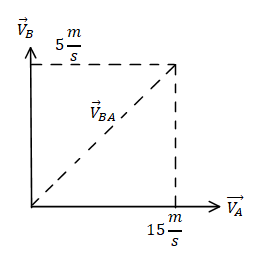
Man A sitting in a car moving with a speed of $54 km/hr$ observes a man B in front of the car crossing perpendicularly a road of width $15 m$ in three seconds. Then the velocity of man B (in m/s) will be:
A) $5\sqrt {10} $ $\text{towards the car at some angle.}$
B) $5\sqrt {10} $ $\text{away from the car at some angle.}$
C) $\text{5 perpendicular to the road.}$
D) $\text{15 along the road.}$
Answer
154.2k+ views
Hint: The relative velocity is the velocity of a body with respect to another body. Generally the velocity is represented with respect to the ground but sometimes the point of reference changes and we need to then solve and get the relative velocity of the body.
Complete step by step solution:
The speed of man A in $m/s$ is equal to,
$ \Rightarrow 54 \times \dfrac{5}{{18}} = 15m/s$
The speed of man B is equal to,
$ \Rightarrow {V_B} = \dfrac{{15}}{3} m/s$
$ \Rightarrow {V_B} = 5m/s$.
Since the man A observes the man B moving in the perpendicular direction then the vector representation can be used to solve this further.

Let resultant velocity of the velocity of man B with respect to man A is given by ${V_{BA}}$.
The magnitude of the speed of the man B observed from man A is given by.
Applying Pythagoras we get,
$ \Rightarrow {V_{BA}} = \sqrt {{5^2} + {{15}^2}} $
$ \Rightarrow {V_{BA}} = \sqrt {25 + 225} $
$ \Rightarrow {V_{BA}} = \sqrt {250} $
$ \Rightarrow {V_{BA}} = 5\sqrt {10} m/s$.
The speed of man B with respect to man A is equal to ${V_{BA}} = 5\sqrt {10} m/s$ and is away from the car at some angle.
The correct answer for this problem is option B.
Note: The vector addition and subtraction is very useful in solving problems like these and therefore it is advised for students to understand and remember the formula of the vector addition and vector substation and also the magnitude calculation of the same.
Complete step by step solution:
The speed of man A in $m/s$ is equal to,
$ \Rightarrow 54 \times \dfrac{5}{{18}} = 15m/s$
The speed of man B is equal to,
$ \Rightarrow {V_B} = \dfrac{{15}}{3} m/s$
$ \Rightarrow {V_B} = 5m/s$.
Since the man A observes the man B moving in the perpendicular direction then the vector representation can be used to solve this further.

Let resultant velocity of the velocity of man B with respect to man A is given by ${V_{BA}}$.
The magnitude of the speed of the man B observed from man A is given by.
Applying Pythagoras we get,
$ \Rightarrow {V_{BA}} = \sqrt {{5^2} + {{15}^2}} $
$ \Rightarrow {V_{BA}} = \sqrt {25 + 225} $
$ \Rightarrow {V_{BA}} = \sqrt {250} $
$ \Rightarrow {V_{BA}} = 5\sqrt {10} m/s$.
The speed of man B with respect to man A is equal to ${V_{BA}} = 5\sqrt {10} m/s$ and is away from the car at some angle.
The correct answer for this problem is option B.
Note: The vector addition and subtraction is very useful in solving problems like these and therefore it is advised for students to understand and remember the formula of the vector addition and vector substation and also the magnitude calculation of the same.
Recently Updated Pages
JEE Atomic Structure and Chemical Bonding important Concepts and Tips

JEE Amino Acids and Peptides Important Concepts and Tips for Exam Preparation

JEE Electricity and Magnetism Important Concepts and Tips for Exam Preparation

Chemical Properties of Hydrogen - Important Concepts for JEE Exam Preparation

JEE Energetics Important Concepts and Tips for Exam Preparation

JEE Isolation, Preparation and Properties of Non-metals Important Concepts and Tips for Exam Preparation

Trending doubts
If the unit of power is 1Kilo Watt the length is 100m class 11 physics JEE_Main

Which of the following statements is correct if the class 11 physics JEE_Main

The quantity of heat required to heat one mole of a class 11 physics JEE_Main

IIIT JEE Main Cutoff 2024

Photoelectric Effect and Stopping Potential with Work Function and Derivation for JEE

Newton’s Laws of Motion: Three Laws of Motion Explanation with Examples

Other Pages
JEE Advanced 2025 Revision Notes for Mechanics

Ideal and Non-Ideal Solutions Raoult's Law - JEE

JEE Main 2025: Conversion of Galvanometer Into Ammeter And Voltmeter in Physics

A boy wants to throw a ball from a point A so as to class 11 physics JEE_Main

List of Fastest Century In IPL - Cricket League and FAQs

NEET 2025: All Major Changes in Application Process, Pattern and More




